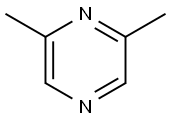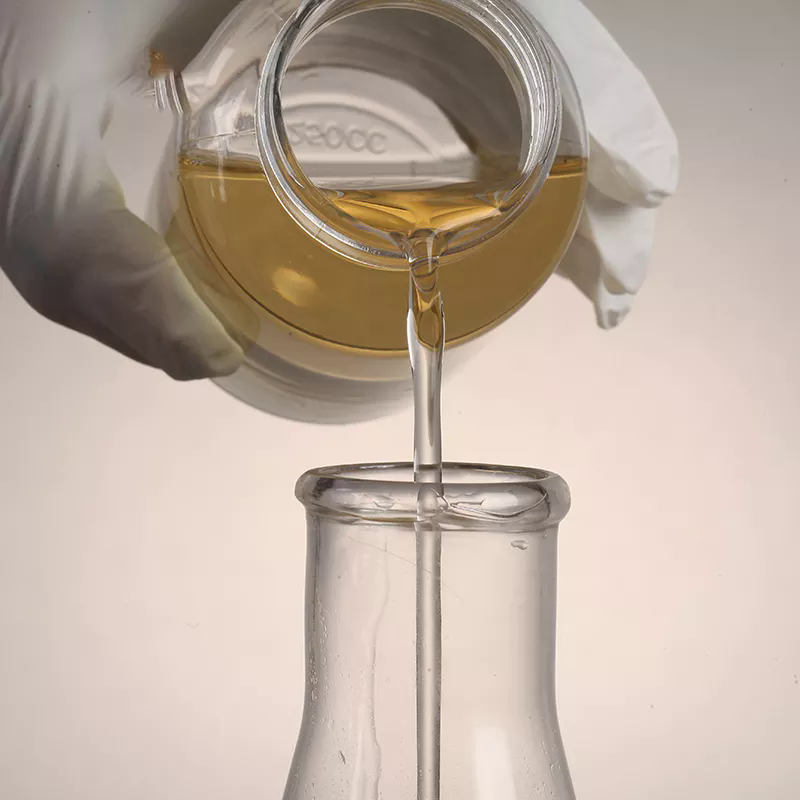2,3-Dimethylpyrazine
- CAS NO.:5910-89-4
- Empirical Formula: C6H8N2
- Molecular Weight: 108.14
- MDL number: MFCD00006144
- EINECS: 227-630-0
- SAFETY DATA SHEET (SDS)
- Update Date: 2024-12-18 14:15:32

What is 2,3-Dimethylpyrazine?
Chemical properties
CLEAR YELLOW TO ORANGE LIQUID
Chemical properties
2,3-Dimethylpyrazine has a nutty, cocoa-like odor and green note.
What are the applications of Application
2,3-Dimethylpyrazine is a medium for bacterium strain DP-45, identified as Rhodococcus erythropolis to grow on
Definition
ChEBI: 2,3-Dimethylpyrazine is a member of pyrazines.
Synthesis Reference(s)
The Journal of Organic Chemistry, 28, p. 1703, 1963 DOI: 10.1021/jo01041a506
General Description
The bacterium strain DP-45, identified as Rhodococcus erythropolis, was grown on 2,3-dimethylpyrazine.
Safety Profile
Moderately toxic by ingestion and intraperitoneal routes. Flammable liquid when exposed to heat, sparks, or flame. When heated to decomposition it emits toxic fumes of NOx
Properties of 2,3-Dimethylpyrazine
| Melting point: | 11-13 °C |
| Boiling point: | 156 °C (lit.) |
| Density | 1.011 g/mL at 25 °C (lit.) |
| refractive index | n |
| FEMA | 3271 | 2,3-DIMETHYLPYRAZINE |
| Flash point: | 130 °F |
| storage temp. | Inert atmosphere,Room Temperature |
| solubility | Chloroform (Sparingly), Methanol (Slightly) |
| pka | 2.21±0.10(Predicted) |
| form | clear liquid |
| Specific Gravity | 1.022 |
| color | Colorless to Light orange to Yellow |
| PH | 7 (H2O, 20℃) |
| Odor | roasted odor, reminiscent of nuts |
| JECFA Number | 765 |
| BRN | 107908 |
| CAS DataBase Reference | 5910-89-4(CAS DataBase Reference) |
| NIST Chemistry Reference | Pyrazine, 2,3-dimethyl-(5910-89-4) |
| EPA Substance Registry System | Pyrazine, 2,3-dimethyl- (5910-89-4) |
Safety information for 2,3-Dimethylpyrazine
| Signal word | Danger |
| Pictogram(s) |
 Flame Flammables GHS02  Corrosion Corrosives GHS05  Exclamation Mark Irritant GHS07 |
| GHS Hazard Statements |
H226:Flammable liquids H302:Acute toxicity,oral H315:Skin corrosion/irritation H318:Serious eye damage/eye irritation H335:Specific target organ toxicity, single exposure;Respiratory tract irritation |
| Precautionary Statement Codes |
P210:Keep away from heat/sparks/open flames/hot surfaces. — No smoking. P233:Keep container tightly closed. P280:Wear protective gloves/protective clothing/eye protection/face protection. P301+P312:IF SWALLOWED: call a POISON CENTER or doctor/physician IF you feel unwell. P303+P361+P353:IF ON SKIN (or hair): Remove/Take off Immediately all contaminated clothing. Rinse SKIN with water/shower. P305+P351+P338:IF IN EYES: Rinse cautiously with water for several minutes. Remove contact lenses, if present and easy to do. Continuerinsing. |
Computed Descriptors for 2,3-Dimethylpyrazine
2,3-Dimethylpyrazine manufacturer
Aamirav Ingredients And Specialties Pvt Ltd
1Y
Phone:+919820077171
Whatsapp: +91-9820077171
product: 5910-89-4 2,3-Dimethylpyrazine 98%
New Products
Tert-butyl bis(2-chloroethyl)carbamate 4-Methylphenylacetic acid N-Boc-D-alaninol N-BOC-D/L-ALANINOL N-octanoyl benzotriazole 3-Morpholino-1-(4-nitrophenyl)-5,6-dihydropyridin- 2(1H)-one Furan-2,5-Dicarboxylic Acid DIETHYL AMINOMALONATE HYDROCHLORIDE 1,1’-CARBONYLDIIMIDAZOLE R-2-BENZYLOXY PROPIONIC ACID 1,1’-CARBONYLDI (1,2-4 TRIAZOLE) N-METHYL INDAZOLE-3-CARBOXYLIC ACID (2-Hydroxyphenyl)acetonitrile 4-Bromopyrazole 5-BROMO-2CYANO PYRIDINE 5,6-Dimethoxyindanone 5-broMo-2-chloro-N-cyclopentylpyriMidin-4-aMine 2-(Cyanocyclohexyl)acetic acid 4-methoxy-3,5-dinitropyridine 1-(4-(aminomethyl)benzyl)urea hydrochloride 2-aminopropyl benzoate hydrochloride diethyl 2-(2-((tertbutoxycarbonyl)amino) ethyl)malonate tert-butyl 4- (ureidomethyl)benzylcarbamate Ethyl-2-chloro((4-methoxyphenyl)hydrazono)acetateRelated products of tetrahydrofuran








You may like
-
 5910-89-4 2,3-Dimethylpyrazine 98%View Details
5910-89-4 2,3-Dimethylpyrazine 98%View Details
5910-89-4 -
 2,3-Dimethylpyrazine CAS 5910-89-4View Details
2,3-Dimethylpyrazine CAS 5910-89-4View Details
5910-89-4 -
 2,3-Dimethylpyrazine CAS 5910-89-4View Details
2,3-Dimethylpyrazine CAS 5910-89-4View Details
5910-89-4 -
 1975-50-4 98%View Details
1975-50-4 98%View Details
1975-50-4 -
 2-HYDROXY BENZYL ALCOHOL 98%View Details
2-HYDROXY BENZYL ALCOHOL 98%View Details
90-01-7 -
 14714-50-2 (2-Hydroxyphenyl)acetonitrile 98+View Details
14714-50-2 (2-Hydroxyphenyl)acetonitrile 98+View Details
14714-50-2 -
 118753-70-1 98+View Details
118753-70-1 98+View Details
118753-70-1 -
 733039-20-8 5-broMo-2-chloro-N-cyclopentylpyriMidin-4-aMine 98+View Details
733039-20-8 5-broMo-2-chloro-N-cyclopentylpyriMidin-4-aMine 98+View Details
733039-20-8
Statement: All products displayed on this website are only used for non medical purposes such as industrial applications or scientific research, and cannot be used for clinical diagnosis or treatment of humans or animals. They are not medicinal or edible.